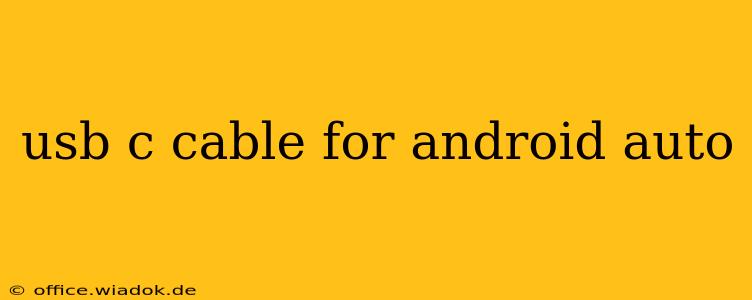Android Auto has revolutionized in-car entertainment and navigation, offering a seamless and safe way to integrate your Android smartphone with your vehicle's infotainment system. But to unlock this functionality, you need a reliable USB-C cable. Choosing the right one can be tricky, so this guide will walk you through the essential factors to consider when selecting a USB-C cable specifically for Android Auto.
Understanding the Importance of Cable Quality for Android Auto
While any old USB-C cable might seem to work, using an inferior cable for Android Auto can lead to frustrating issues. These include:
- Intermittent Connections: A poorly made cable can cause your phone to disconnect frequently, interrupting navigation, music playback, and calls.
- Slow Data Transfer Speeds: Android Auto relies on a fast data connection. A slow cable can result in laggy performance and delays in app loading.
- Charging Issues: Some cables only support charging, not data transfer. This renders Android Auto unusable.
- Power Delivery Problems: Insufficient power delivery can cause your phone to drain its battery while connected, defeating the purpose of in-car charging.
Key Factors to Consider When Choosing a USB-C Cable for Android Auto
Several key features differentiate a good USB-C cable from a bad one for Android Auto use:
1. Data Transfer Speed:
Look for cables explicitly stating support for USB 2.0 or higher. USB 3.0 or 3.1 will offer even faster data transfer speeds, leading to a smoother Android Auto experience. While USB-C supports these faster speeds, the cable itself must also be designed and manufactured to those specifications.
2. Cable Length:
Choose a cable length that comfortably reaches your phone's placement in your vehicle while avoiding excess slack which could be a tripping hazard. Common lengths range from 3ft to 6ft, but you may need a longer cable depending on your car's design.
3. Build Quality and Durability:
A robustly constructed cable is crucial for longevity. Look for cables with:
- Reinforced Connectors: Sturdy connectors at both ends resist bending and breaking.
- Durable Braiding or Sheathing: A braided or heavily sheathed cable provides better protection against wear and tear from repeated bending and movement.
- High-Quality Materials: Avoid flimsy cables made from cheap materials—they're more prone to failure.
4. Certification:
While not strictly mandatory, look for cables that are certified by USB-IF (USB Implementers Forum). This certification indicates the cable meets specific performance standards. It's not a guarantee of perfection, but it's a good indicator of quality.
5. Power Delivery (PD) Capabilities:
Consider the power delivery capabilities, especially if you intend to charge your phone while using Android Auto. A higher wattage capacity means faster charging. Look for cables supporting at least 18W PD for efficient and fast charging.
Troubleshooting Common Android Auto Cable Issues
Even with a high-quality cable, you might encounter problems. Here are some troubleshooting tips:
- Try a Different Cable: The simplest fix is often trying another cable known to be compatible with Android Auto.
- Check Your Phone's USB Settings: Ensure your phone is set to allow data transfer over USB.
- Inspect the Cable and Ports for Damage: Look closely at both ends of the cable and your car's USB port for any signs of damage or debris.
- Restart Your Phone and Car's Infotainment System: A simple restart can resolve software glitches that interfere with the connection.
- Update Your Phone's Software: Outdated software can create compatibility issues.
Conclusion: Investing in the Right Cable Matters
Choosing the right USB-C cable for Android Auto is an investment in a smoother, safer, and more enjoyable driving experience. By understanding the key factors discussed above and carefully selecting a high-quality cable, you can avoid the frustration of intermittent connections and ensure your Android Auto setup runs flawlessly. Remember to prioritize data transfer speed, build quality, and power delivery capabilities for optimal performance.

